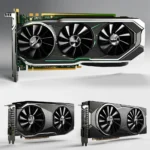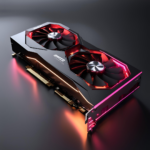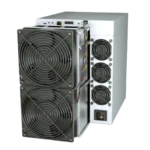The Nvidia RTX 4070 Ti, released in January 2023, is a high-performance GPU with specifications that cater well to various mining algorithms. This guide provides recommended overclock settings, client software, cooling tips, and a profitability table to optimize your mining experience with this GPU.
Nvidia RTX 4070 Ti Specifications
- Release: January 2023
- Base Clock: 2310 MHz
- Boost Clock: 2610 MHz
- GPU Power: 285 W
- CUDA Cores: 7680
- Max Memory Size: 12 GB
- Memory Type: GDDR6X
Recommended Overclock Settings
To achieve optimal mining performance, consider the following overclock settings:
- Operating System: msOS / Windows
- Power Limit: 285 W
- Core Clock: Adjust depending on the algorithm (usually lower for better efficiency)
- Memory Clock: +1300 MHz (may vary by algorithm)
- Fan Speed: 80-100% based on thermal conditions
Software Choice
The NBMiner client is a preferred choice for the Nvidia RTX 4070 Ti, offering stability and support across various algorithms that leverage the card’s capabilities.
Cooling Tips
With a power rating of 285 W, the RTX 4070 Ti can run hot, especially when used continuously for mining. Set the fan speed to a minimum of 80%, and consider enhancing your rig’s cooling with external fans or improved airflow for longevity and consistent performance.
Important Notes
Overclock settings are generalized guidelines and may not yield the same results across all GPUs of this model. Adjust cautiously and monitor results to avoid stability issues or potential hardware damage.
Mining Profitability Table
Here’s a profitability table showing the estimated revenue for various mining algorithms on the Nvidia RTX 4070 Ti. Keep in mind that profitability depends on current market conditions, mining difficulty, and electricity rates.
| # | Name | Algorithm | Hashrate/Power Usage | Est. Daily Revenue | Est. Daily Costs | Est. Daily Profit |
|---|---|---|---|---|---|---|
| 1 | RTM | GhostRider | 1356 H/s, 121 W | $0.17 (~192 RTM) | -$0.29 | -$0.12 |
| 2 | DXPOOL ERG | Autolykos2 | 120.77 MH/s, 153 W | $0.21 (~0.29 ERG) | -$0.37 | -$0.16 |
| 3 | HIVEON RVN | KAWPOW | 29.78 MH/s, 225 W | $0.38 (~21.79 RVN) | -$0.54 | -$0.16 |
| 4 | CFX | Octopus | 58.44 MH/s, 220 W | $0.35 (~2.41 CFX) | -$0.53 | -$0.17 |
| 5 | UNM Autolykos2 | Autolykos2 | 120.77 MH/s, 153 W | $0.18 (~0.000002 BTC) | -$0.37 | -$0.19 |
| 6 | ZP GhostRider | GhostRider | 1356 H/s, 121 W | $0.10 (~0.000001 BTC) | -$0.29 | -$0.19 |
| 7 | 2MINERS ERG | Autolykos2 | 120.77 MH/s, 153 W | $0.17 (~0.24 ERG) | -$0.37 | -$0.19 |
| 8 | zpool GhostRider | GhostRider | 1356 H/s, 121 W | $0.09 (~0.000001 BTC) | -$0.29 | -$0.20 |
| 9 | NANOPOOL CFX | Octopus | 58.44 MH/s, 220 W | $0.33 (~2.26 CFX) | -$0.53 | -$0.20 |
| 10 | NH Octopus | Octopus | 58.44 MH/s, 220 W | $0.33 (~0.000004 BTC) | -$0.53 | -$0.20 |
| 11 | ERG | Autolykos2 | 120.77 MH/s, 153 W | $0.17 (~0.23 ERG) | -$0.37 | -$0.20 |
| 12 | NH Autolykos2 | Autolykos2 | 120.77 MH/s, 153 W | $0.16 (~0.000002 BTC) | -$0.37 | -$0.21 |
| 13 | BTCZ | Zhash | 108 H/s, 258 W | $0.41 (~16,408 BTCZ) | -$0.62 | -$0.21 |
| 14 | BINANCE RVN | KAWPOW | 29.78 MH/s, 225 W | $0.33 (~18.86 RVN) | -$0.54 | -$0.21 |
| 15 | CLORE | KAWPOW | 29.78 MH/s, 225 W | $0.32 (~3.88 CLORE) | -$0.54 | -$0.22 |
| 16 | 2MINERS BTG | Zhash | 108 H/s, 258 W | $0.40 (~0.02 BTG) | -$0.62 | -$0.22 |
| 17 | ANTPOOL RVN | KAWPOW | 29.78 MH/s, 225 W | $0.32 (~18.38 RVN) | -$0.54 | -$0.22 |
| 18 | NANOPOOL ERG | Autolykos2 | 120.77 MH/s, 153 W | $0.15 (~0.20 ERG) | -$0.37 | -$0.22 |
| 19 | 2MINERS RVN | KAWPOW | 29.78 MH/s, 225 W | $0.31 (~18.15 RVN) | -$0.54 | -$0.23 |
| 20 | F2POOL CFX | Octopus | 58.44 MH/s, 220 W | $0.30 (~2.05 CFX) | -$0.53 | -$0.23 |
Conclusion
The Nvidia RTX 4070 Ti is a capable mining GPU, and with the right settings and software, it can achieve reasonable performance across multiple algorithms. Profitability varies, so it’s crucial to monitor current conditions and adjust configurations as needed. By optimizing power settings and maintaining proper cooling, the RTX 4070 Ti can be a valuable asset in a mining setup.




